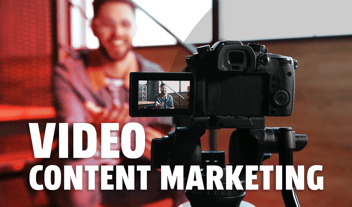The question isn’t whether or not you should be using video on your website and in your marketing mix; you should invest in video content if you want to succeed. End of story, right? Well, not exactly. While video content is a must-have in your marketing mix, it’s important to know when to use video content and how to implement it to maximize your conversions.
Abusing how you are implementing video content could be costing you leads in the long run. So, let’s talk about the do’s and don’ts of video content.
Do: Include a Motion or Video Content on Your Homepage
There’s no doubt that video is an engaging form of content, which makes it wise to include a video or motion graphics on your website’s homepage. In fact, Social Media Week published a number of statistics on video marketing. This one shows the benefit of having a video on your homepage; viewers retain 95% of a message when they watch it through video.
Don’t: Make Video or Motion Content Too Distracting
Large video header areas have been super popular. Yet, it's debated if they are effective. Do they drive users to take a particular action, or does the video distract them instead?
They look cool for sure, but too many changing things or scrolling copy could make your ultimate message and call to action get lost.
Consider how you can add video, motion, and other interactive content to your site in other meaningful ways. For example, add CSS animations with actions on click or scroll animated video buttons that draw attention to the video content or player button. Or, add short, simple video clips or motion graphics in select areas of your website. These are all popular ways of including videos to eye-catching areas of interest without taking away from other important areas of your website.
Do: Direct Users to Your Video Content
This is done in several ways. Include a CTA to watch a video. Include compelling copy about why watching your video is beneficial. Add some subtle animation to the play button and use colors that help the button to stand out. Also, consider placing it above the fold.
Don’t: Set Your Videos to Autoplay With Audio
Seriously, it’s annoying. You forget how loud your volume is, go to a website, while your kids are napping or your co-worker is on the phone and then BAM!
You’re scrambling to either find volume control or the X to close it because you’re so flustered. You just want it to stop. Viewers may never end up watching it after that. If you must play your video automatically, consider silent auto-play, so your video will play, but without the sound enabled. Also, be sure to add captions so users can follow along without needing to use their audio.
Do: Create User Generated Content
User-generated content is homemade. With the rise of TikTok, more and more brands are using homemade video content. It’s relatively easy to use, accessible and consumers love this more raw, personal approach.
While most brands release this content with a purpose in mind and a plan, sometimes this content is used for off-the-cuff, real glimpses into your brand.
Users appreciate getting an exclusive look inside your business and brand and gain helpful insight into your products and services. While this is ultimately great for social media, where users are looking for an authentic look at your brand, incorporating it into your website could prove valuable to your users, depending on the content.
Also, don’t overlook linking to your YouTube account or pulling in a feed from your social media pages as well. Directing users to these accounts may not help your bounce rate, but it will increase your users' trust and familiarity with your brand.
Don’t: Make Video Content Too Long
If your videos are crammed with every single thing about your company, then chances are, you’re putting your audience to sleep. Yes, video is engaging, but if you ramble on and on without taking into consideration your audience’s problem and your solution, then you’re doing it wrong.
Aim to keep your video two minutes or less. If you need more, consider making it a a two or three part series. Not only will it expand your content calendar, but your audience will thank you for not drawing on and on for five-plus minutes.
Understanding user behavior and driving them to take a definitive action is an art in and of itself. There are many moving parts and things to take into consideration. At the end of the day, the data will tell you what worked and didn’t.
The key takeaway is this: while your website is going to be a huge central hub for building brand awareness, establishing trust, and create conversions alike, it is very easy to quickly add too many different things to it that could ultimately deter users from sticking around.
Video is an extremely powerful marketing tool when used properly. Data is even more powerful. Don’t be fooled into thinking the biggest, loudest displays will always yield the best results. Sometimes, less is truly more.
Need help creating a professional video for your website? We'd love to help. We provide full-service video production services from strategy and creative through production and placement.





